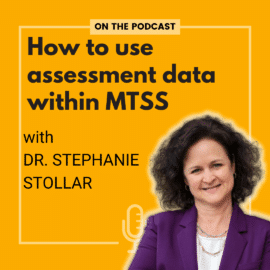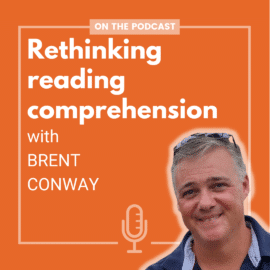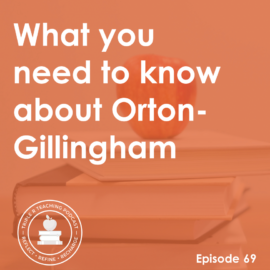
TRT Podcast#38: What the science of reading is based on
There are a lot of questions about what the science of reading truly is. Is it from a journalist? Is the science brand-new? How do we know that we can trust it? In today’s episode I’ll share the particulars!
Listen to the episode here
Full episode transcript
I've heard a lot of opinions about the science of reading. Some people think it's the invention of a journalist who doesn't know what she's talking about. Others question if it's something we can really trust. Is this all brand-new science? Has it even been proven? In today's episode, we're going to talk about what the science of reading really is and why you CAN trust it.
Last week, we talked about what the science of reading is, and our definition is a body of basic research on reading. The research has been conducted for decades and has important implications for how we teach reading. Last week, we talked about the human brain and how it learns to read, and we made this really, really simple. It's actually quite complicated, but we put it in the most basic terms.
When you look at the brain, you should know that effective reading takes place in the left hemisphere. We've got something in the back of our brain we like to call the orthographic processor - it's not the scientific name, but it's where we recognize letters and words. Then towards the front of that left side of the brain, we've got the phonological processor, which is where we recognize sounds. Then sort of in the middle back, we have the phonological assembly region, which allows us to connect speech sounds with visual images. That's really important, because it's that part of the brain that helps us sort of connect the circuits - make the two parts work together.
Scientists have studied brains of people who are not strong readers, and they find that instead of having this well-developed phonological assembly region on the left side of the brain, they're doing a lot of their reading work on the right side of the brain, which is not efficient. The way that we can help strengthen this phonological assembly region is to teach kids to connect sounds to print. So we talked a lot about phonological awareness and then phonics and how we can help kids connect the phonemes - the sounds, to the written letters - the graphemes, through systematic explicit phonics instruction.
But this is just one part of the science of reading. Neuroscience is just one piece. If you join any conversation about the science of reading, almost inevitably two things are going to come up, and here they are: the simple view of reading and Scarborough's Reading Rope. Today we're going to talk about both of those things, the simple view of reading and Scarborough's Reading Rope.
We're going to start with the simple view. This is a theory represented by a mathematical formula, which defines the two basic domains that are required for reading comprehension to take place. It was proposed by Gough and Tunmer in 1986. I'm not sure about you, but in 1986 I was eight years old, so this happened long before I got into undergrad and before I got my master's degree in curriculum and instruction with a focus on teaching reading. Yet I never learned about the simple view of reading either in undergrad or graduate school! However, it's been around for a long time.
In fact, it's been supported by research many times over, and no one has been able to prove it false! That's really good to know, because I know for some people, they hear the science of reading, and because this is kind of just getting into the mainstream in the last couple of years, it feels like it's just a pendulum and is only a fad. But it's actually been around for a long time!
One thing, I think, no matter what side of the reading wars we might be on, we can all agree that reading comprehension is the goal of reading, right? We all agree that that's where we want our students to get. The question is how do they get there?
The simple view of reading shows us that reading comprehension is a product of decoding and language comprehension. So when we have both of those things, then reading comprehension can take place. It's really important to remember that this is a multiplication equation and NOT an addition problem, okay?
So when we think about decoding, we also think of that as just being word recognition. There are some things that have to be learned for that to happen. We want to teach phonemic awareness and phonics. So, again, phonemic awareness is that ability to play with sounds in words, and phonics is connecting those sounds to actual letters. Then we also want to build language comprehension, and that involves things like vocabulary and text comprehension. Text comprehension is a little more abstract, but that includes things like syntax, text structure, and other things.
Fluency then, is the application of decoding and language skills, the automatic application. So when children become automatic in their decoding and connecting the words they're reading to what they already know with language comprehension, that's when fluent reading can occur. These pieces together lead us to reading comprehension, which is, of course, the goal of reading.
Like I said, it's really important to remember this is a multiplication, not addition problem.
Let's take a look at some scenarios. I can think of myself when I took Spanish in high school a long time ago, about 25 years ago. I don't remember much of it now, to be honest, because that was a long time ago and I haven't used it. But I can still decode words in Spanish, because unlike English, they're relatively consistent in terms of the sounds connected to the letter, so it's pretty easy to "read Spanish" out loud.
If you gave me a page of Spanish text, I could read it to you, so you would probably give me a decoding score of one, BUT my vocabulary in Spanish is very poor. I probably know fewer than 50 words, so that would have to be assigned a zero. Therefore, even though I could read the words out loud, my reading comprehension would not be happening. It would be a zero. One times zero equals zero.
Let's think about another situation. Can you for a minute think about a student you have had who's very bright, who can have really strong conversations with you and has good vocabulary? When they listen to you read aloud, they're just totally into it. They can answer all the questions, but they struggle to get words off a page. In that instance, the child would have a decoding score of zero, and a language comprehension score of one, which unfortunately leads to a reading comprehension score of zero. It's really important that kids can decode AND have understanding of the language in order for reading comprehension to take place.
So you might say, "Who cares? That's interesting, but it doesn't matter to me. What am I going to do with that?"
I would say, well, it matters because not all children who have trouble reading, or who have trouble understanding what they read have the same problem.
I was talking to a friend of mine, a school psychologist, and she said that she often finds that when they have kids that come to them around fifth grade, struggling to read or to understand what they read, teachers often assume it's a comprehension issue. They focus on that instead of checking to see if it's a decoding issue. So the problem could be decoding, or the problem could be language comprehension. We have to be able to look through all the possibilities before we decide on the intervention. The simple view of reading gives us this big picture of what could be at play when kids are struggling to comprehend.
Now, you might be thinking about the simple view of reading and saying, "Okay, I've taught kids how to read, and it's not simple. It's not that simple. It's complicated."
To that, I would say I totally agree with you, and my only beef with the simple view of reading is that it's called "the simple view of reading".
Now, I know that the people who created it would not tell you that learning to read is simple. They're just trying to show all the big domains that all the sub-skills rest under. But it's really good to use something else next to the simple view of reading, and that is Scarborough's Reading Rope, because that's where we're going to see all the pieces.
Scarborough's Reading Rope was created by Dr. Hollis Scarborough in the 1990s, and it was published in 2001. Interestingly, she created this as a visual for the parents and teachers who were attending her presentations. She wanted to show them all the complexities involved in learning to read. It's so interesting to me that she actually designed this for people like you and me. At least I'm assuming you're like me, that you're not research-oriented. You don't spend hours and hours studying research articles in journals. We maybe read them occasionally, but it's not something we're heavily involved in. That's why she created the Reading Rope.
This is what it looks like - she drew this herself. It's two ropes that are becoming entwined together as the strands get tighter and tighter. So if you're listening to this on the podcast, you should go ahead and Google Scarborough's Reading Rope so you can see what I'm talking about here.
Interestingly, Hollis Scarborough created this completely separate from the simple view of reading. She was not familiar with it when she created this, and yet she also came up with two domains for proficient reading based on the research, word recognition and language comprehension.
So in the model, she labels each of these strands with the sub-skills of word recognition and language comprehension. Those are phonological awareness, decoding, and sight recognition. Those are the sub-skills of word recognition, and just to be clear, sight recognition does not mean memorizing lists of sight words. It means being able to read any word quickly and accurately, whether or not it's high frequency. So for my little boy who's learning to read, who's five years old, the word "cat" could be a word in his sight recognition. He recognizes that word instantly. Another word that could be in there is "the". That's not phonetic, and yet he can read that instantly as well. It's any word they can read instantly.
Talking about language comprehension, these are the things that are involved there, background knowledge, vocabulary, language structure, verbal reasoning, and literacy knowledge. So as you can see, learning to read is not as simple as the simple view of reading might lead us to believe. It's actually quite complicated. All of these things are part of it.
The rope helps us see the change over time in the relationships of the strands and bundles. So back to that visual, if you're looking with me on Facebook, you can see that the strands get tighter and tighter and tighter as reading becomes more skilled. So the word recognition becomes more automatic, the language comprehension becomes more strategic, and then as that rope becomes tighter and tighter, we get to skilled reading. Scarborough in an interview stated that the rope allows us to talk about a concrete thing, a rope made of strands, as a metaphor for what research has shown to be important about becoming a good reader. She also said if any of the strands get frayed, it can hold back the development of other strands and, by extension, eventually weaken the entire rope. She saw these as strengths of the model.
Again, you might say, "All right. Nice visual, but who cares? Why does this matter for me as a reading teacher?"
I say, "Good question." That's always something we should be asking when we're looking at things like this. It's important for a few reasons. One thing it does is it helps us find strengths and deficits in a proposed curriculum. So let's say you're looking at a possible reading program for your school, and you're saying, "Okay, so this curriculum has lots of decoding practice in it, so a very strong phonics component, but it's not really touching on phonological awareness." Well, if that's true, then you need to either reconsider the curriculum or supplement it. You might have a different curriculum which has really good language comprehension pieces, so it talks a lot about background knowledge and vocabulary and so on, but the decoding piece is really weak. It does not include systematic sequential phonics instruction. If that's the case, you're going to want to reconsider this program.
Having Scarborough's Reading Rope in front of you allows you to be more wise about programs that you choose. We can also use it to help us determine strengths and weaknesses of individual students so we choose the right intervention. This is just a really good, big picture view of all the things that are at play when it comes to becoming a skilled reader.
Here are some key takeaways for you today. To understand the science of reading, we should be aware of the neuroscience, which I talked about last week, the simple view of reading, and Scarborough's Reading Rope. We should know that these findings are not new and they have been proven time and time again. Now, it's true that for many of us, myself included, learning about this has been new. That could probably be a whole other episode about why we didn't know about this until now, but it's been around.
We should know that the science of reading continues to grow as more research is done. I don't think we're in the final iteration of Scarborough's Reading Rope. I think that things are going to be added and adjusted to it as scientists learn more about skillful reading. In the same way, we're going to learn more about how the brain learns to read, and that's going to add more information to what we know about the neuroscience of reading.
We should know that the science of reading is not just about phonics. It's actually a response to the reading wars, because both the simple view of reading and Scarborough's Reading Rope acknowledge that there are two parts, two domains, word recognition and language comprehension. Those are both necessary for students to become strong readers.
If you're hearing all that and you're saying, "Yeah, I knew that. I've been doing balanced literacy for a long time, and I totally understand that phonics and language comprehension are important, and that's why I teach both of them," I would say, "Well, that's exactly what I would have said six months ago," because that's certainly what I believed - that I was giving adequate attention to both. It's possible that you really are giving strong phonics instruction and you really are giving strong attention to language comprehension, but here's the problem...
The problem is something that is very prevalent in balanced literacy curricula, and that's called three cueing. If I say this and you want to run away because you love three cueing, just as I always have, stick with me just for a few minutes, okay?
For those of you that aren't familiar with three cueing, three cueing is the idea that children use three cues as they read, syntactic cues - grammar, semantic cues - what makes sense, and graphophonic cues - phonics, sometimes called the visual cue. Often when you hear teachers prompting children, especially beginning readers who are reading in those early-level texts, they will use cues like these. "What looks right? Does it sound right? Use the picture." They believe that in using all these cues, they're helping kids become skillful readers. I have certainly believed that. I've certainly taught that way.
The problem is that three cueing bypasses some really important things that need to be happening as children are learning to read, and we're going to get into all of that next week.
Thanks so much for joining me today for Episode 38 of Triple R Teaching. Next week, we're going to get deep into three cueing. I'll see you then!
Sign up to receive email updates
Enter your name and email address below and I'll send you periodic updates about the podcast.
Link to original Facebook Live presentation
Check out the full science of reading bootcamp
- Introduction to the series
- Episode 1: What are the reading wars?
- Episode 2: My reaction to the article that reignited the reading wars
- Episode 3: How the brain learns to read
- Episode 4: What the science of reading is based on
- Episode 5: What’s wrong with three-cueing?
- Episode 6: Should you use leveled or decodable books?







Leave a Comment